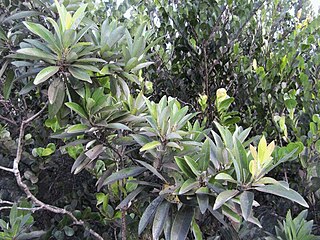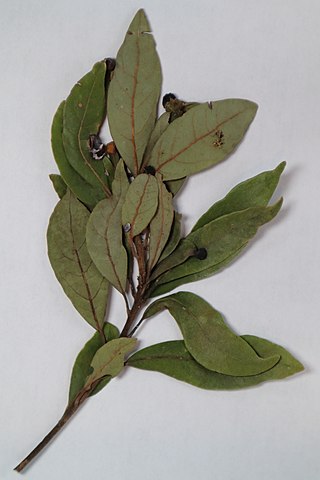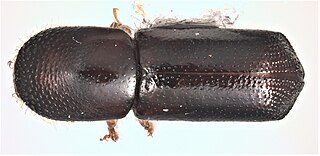
Lauraceae, or the laurels, is a plant family that includes the true laurel and its closest relatives. This family comprises about 2850 known species in about 45 genera worldwide. They are dicotyledons, and occur mainly in warm temperate and tropical regions, especially Southeast Asia and South America. Many are aromatic evergreen trees or shrubs, but some, such as Sassafras, are deciduous, or include both deciduous and evergreen trees and shrubs, especially in tropical and temperate climates. The genus Cassytha is unique in the Lauraceae in that its members are parasitic vines. Most laurels are highly poisonous.

Umbellularia californica is a large hardwood tree native to coastal forests and the Sierra foothills of California, and to coastal forests extending into Oregon. It is endemic to the California Floristic Province. It is the sole species in the genus Umbellularia.

Prunus laurocerasus, also known as cherry laurel, common laurel and sometimes English laurel in North America, is an evergreen species of cherry (Prunus), native to regions bordering the Black Sea in southwestern Asia and southeastern Europe, from Albania and Bulgaria east through Turkey to the Caucasus Mountains and northern Iran.

Ilex opaca, the American holly, is a species of holly, native to the eastern and south-central United States, from coastal Massachusetts south to central Florida, and west to southeastern Missouri and eastern Texas.

Magnolia grandiflora, commonly known as the southern magnolia or bull bay, is a tree of the family Magnoliaceae native to the Southeastern United States, from Virginia to central Florida, and west to East Texas. Reaching 27.5 m (90 ft) in height, it is a large, striking evergreen tree, with large, dark-green leaves up to 20 cm long and 12 cm wide, and large, white, fragrant flowers up to 30 cm (12 in) in diameter.

Persea is a genus of about 150 species of evergreen trees belonging to the laurel family, Lauraceae. The best-known member of the genus is the avocado, P. americana, widely cultivated in subtropical regions for its large, edible fruit.

Laurel forest, also called laurisilva or laurissilva, is a type of subtropical forest found in areas with high humidity and relatively stable, mild temperatures. The forest is characterized by broadleaf tree species with evergreen, glossy and elongated leaves, known as "laurophyll" or "lauroid". Plants from the laurel family (Lauraceae) may or may not be present, depending on the location.

Ilex aquifolium, the holly, common holly, English holly, European holly, or occasionally Christmas holly, is a species of flowering plant in the family Aquifoliaceae, native to western and southern Europe, northwest Africa, and southwest Asia. It is regarded as the type species of the genus Ilex, which by association is also called "holly". It is an evergreen tree or shrub found, for example, in shady areas of forests of oak and in beech hedges. In the British Isles it is one of very few native hardwood evergreen trees. It has a great capacity to adapt to different conditions and is a pioneer species that repopulates the margins of forests or clearcuts.

Persea schiedeana, the coyo, is an endangered, evergreen tree in the laurel family (Lauraceae), native to tropical forests of southern Mexico and Central America. Its edible fruit resembles that of the avocado, a related tree in the genus Persea. Other common names include aguacate de montaña, aguacatón, chinini, chupte and yas.

Rhododendron maximum is a species of Rhododendron native to the Appalachians of eastern North America, from Alabama north to coastal Nova Scotia. Its common names include great laurel, great rhododendron, rosebay rhododendron, American rhododendron and big rhododendron.

Laurus azorica, the Azores laurel or Macaronesian laurel, is a small, evergreen tree in the laurel family (Lauraceae), found only on the Azores island group in the North Atlantic.

Persea palustris, also known as swamp bay or swampbay, is a small tree or shrub found throughout the Southeastern United States and the Bahamas, with much of its range overlapping with that of its relative Persea borbonia. It is generally not more than 40 feet tall, with bark separated into scales by fissures across its surface. Mature leaves are green, paler on their undersides, which have prominent brownish or reddish-brown hairs. The species prefers swamps and coastal areas, particularly locations with moist, peat-rich soil. It is sensitive to the fungal disease known as laurel wilt, even more so than related species.

Laurel wilt, also called laurel wilt disease, is a vascular disease that is caused by the fungus Raffaelea lauricola, which is transmitted by the invasive redbay ambrosia beetle, Xyleborus glabratus. The disease affects and kills members of the laurel family. The avocado is perhaps the most commercially valuable plant affected by laurel wilt.

Xyleborus glabratus, the redbay ambrosia beetle, is a type of ambrosia beetle invasive in the United States. It has been documented as the primary vector of Raffaelea lauricola, the fungus that causes laurel wilt, a disease that can kill several North American tree species in the family Lauraceae, including redbay, sassafras, and avocado.

Papilio palamedes, the Palamedes swallowtail or laurel swallowtail, is a North American butterfly in the family Papilionidae.

Prunus caroliniana, known as the Carolina laurelcherry, Carolina cherry laurel, Carolina cherry, or Cherry laurel, is a small evergreen flowering tree native to the lowlands of Southeastern United States, from North Carolina south to Florida and westward to central Texas. The species also has escaped into the wild in a few places in California.

Gaylussacia dumosa is a species of flowering plant in the heath family known by the common names dwarf huckleberry, bush huckleberry, and gopherberry. It is native to eastern North America from Newfoundland to Louisiana and Florida. It occurs along the coastal plain and in the mountains.

Lyonia lucida is a species of flowering plant in the family Ericaceae known by the common names fetterbush lyonia, hurrahbush, and staggerbush. Other plants may also be called fetterbush. This broadleaved evergreen plant grows on the coastal plain of the southeastern United States from Virginia to Florida to Louisiana. It also occurs in Cuba.

Smilax laurifolia is a species of flowering plant in the greenbrier family known by the common names laurel greenbrier, laurelleaf greenbrier, bamboo vine, and blaspheme vine. It is native to the southeastern United States, where it occurs along the Gulf and Atlantic coastal plains from Texas to New Jersey, the range extending inland to Arkansas, Oklahoma, and Tennessee. It also occurs in Cuba and the Bahamas.






















